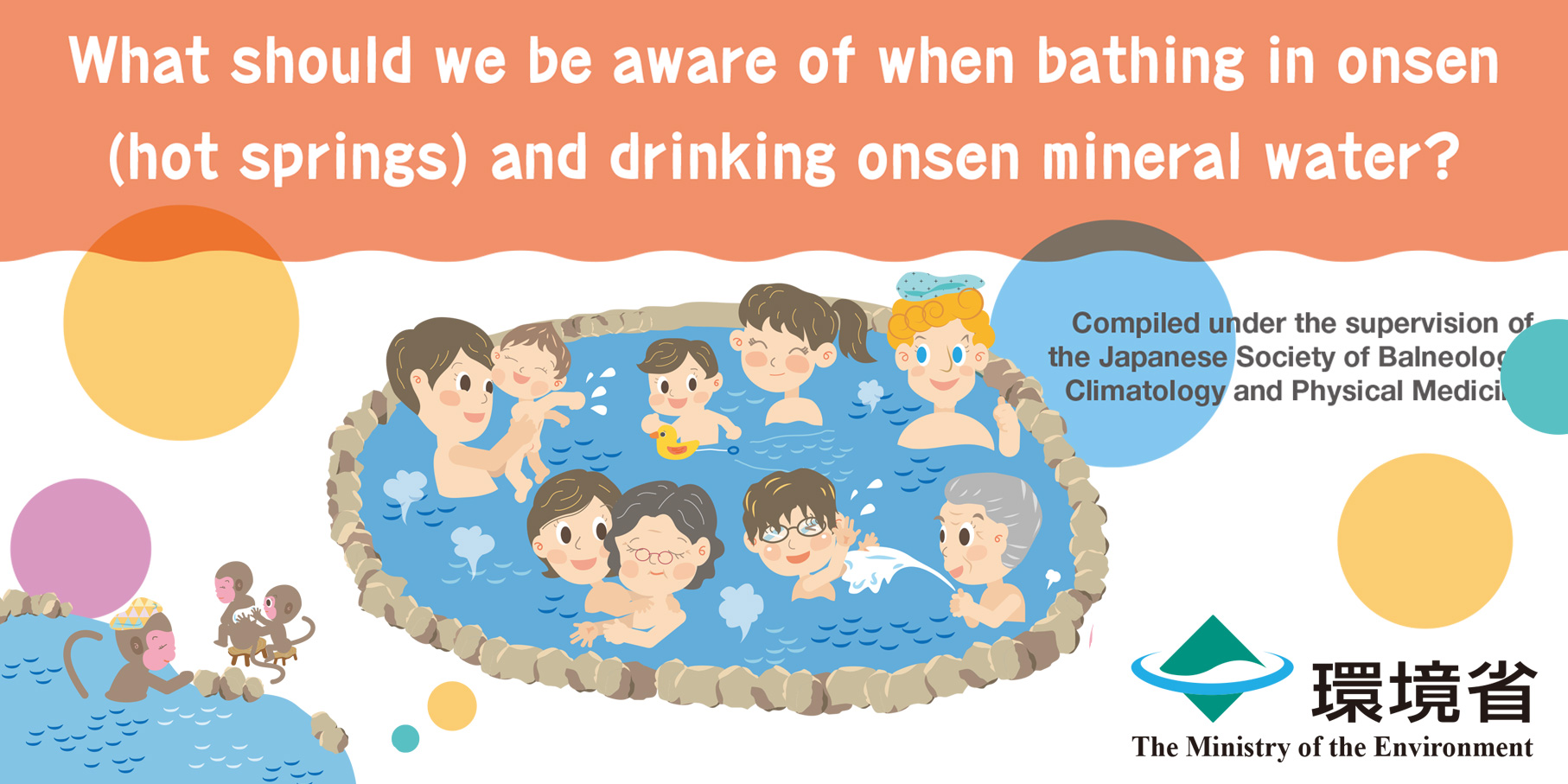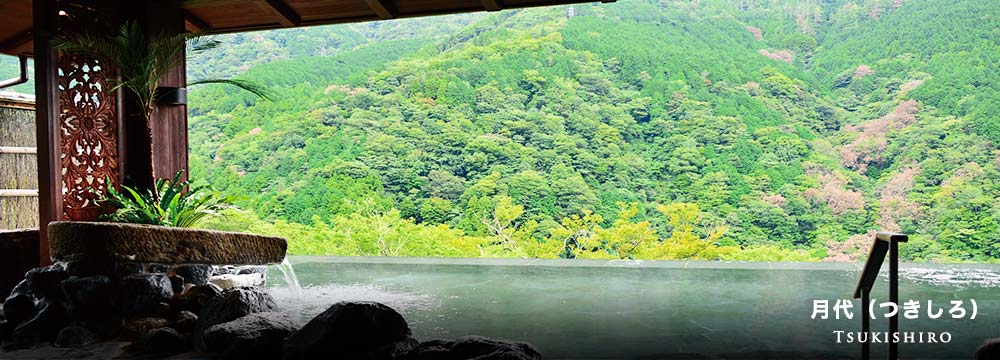- TOP
- Kanto
- Kanagawa(Hakone・Yugawara)
- Hakone Yumoto Onsen
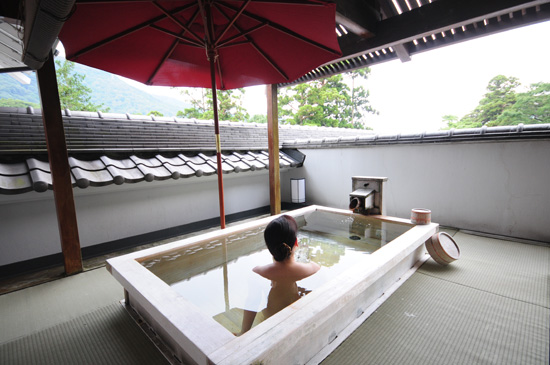
Hakone KAMON
| Sodium, Calcium – Chloride / Sulfate springs | pH |
|
| ナトリウム・カルシウム―塩化物・硫酸塩泉(低張性 弱アルカリ性 高温泉) | ||
| (Hypotonic, Weak alkaline, High temperature Spring) | ||
Ideal for people like this
●Those with sensitivity to cold, ●Those with dry skin,●Those concerned about small cuts and wrinkles,●Those interested in trying skin beautifying effects,●Those feeling stressed- Address
- 435, Yumoto, Hakone-machi, Ashigarashimo-gun, Kanagawa-ken, 250-0311, JAPAN
〒250-0311 神奈川県足柄下郡箱根町湯本435 - Calling from overseas
- +81-460-85-5050
- Calling from Japan
- 0460-85-5050

Official website

Hotel report
Hot Spring Power Chart (5-point scale)
※For kamon Spa’s private open-air bath
Hydrogen Ion Concentration (pH)

- Comment
- Experience smoother skin by removing old keratin with these restorative waters!
Hot spring Specification
※This is an easy-to-understand expression based on the indications for each type of spring in the "Guideline to the Mineral Spring Analysis Methods" revised in July 2014 by the Ministry of the Environment.
| ①Mental recovery | ②Insomnia | ③Promote blood circulation | ④Sensitivity to cold | ⑤Dry skin |
| ⑥Cuts | ⑦Skin diseases | ⑧Hypertension (mild) | ⑨Heartburn (drinking) | ⑩Gastrointestinal disorders (drinking) |
| ⑪Constipation (drinking) | ⑫Lifestyle-related disease | ⑬Diabetes | ⑭Gout | ⑮Countermeasures against metabolic syndrome |
| ⑯Biliary system anxiety (drinking) | ⑰Anaemia | ⑱Arthritis rheumatica | ⑲Spinal pain | ⑳Improved immunity |
| ㉑Muscle pain・Neuralgia | ㉒Mild asthma | ㉓Hemorrhoidal pain | ㉔Recovery from an illness | ㉕Recovery from fatigue |
- ※Note①・・・Indications for each spring include autonomic instability and depression.(Simple springs・Chloride springs・Carbon dioxide springs)
- ※Note③・・・Indications for each spring include peripheral circulatory failure(Chloride springs・Carbonate springs・Carbon dioxide springs・Hydrogen sulfide type sulphur spring)
- ※Note④・・・Indications for each spring include sensitivity to cold(Chloride springs・Carbonate springs・Sulfur springs・Carbon dioxide springs)and Iron containing springs
- ※Note⑦・・・Indications for each spring include xeroderma, atopic dermatitis, plaque psoriasis, epidermoid suppuration, chronic eczema(Chloride springs・Carbonate springs・Sulfate spring・Acidic springs・Sulfur springs)
- ※Note⑨・・・Indications for drinking each spring include reflux esophagitis(Carbonate springs)
- ※Note⑩・・・Indications for drinking each spring include atrophic gastritis, gastroduodenal ulcerations(Chloride springs・Carbonate springs)
- ※Note⑪・・・For drinking, Chloride springs and Sulfate spring
- ※Note⑫・・・Indications for each spring include hypercholesterolemia, diabetes, gout(for bathing, Acidic springs・Radioactive springs/for drinking, Carbonate springs・Iodine containing springs・Sulfur springs)
- ※Note⑮・・・Indications for drinking each spring include hypercholesterolemia(Sulfate spring・Iodine containing springs・Sulfur springs)
- ※Note⑱⑲・・・Indications for each spring include rheumatoid arthritis, ankylosing spondylitis(Radioactive springs)
- ※Note⑳・・・Radioactive springs
- ※Note㉑㉔・・・Simple hot spring water is suitable for rehabilitation due to its low level of stimulation, and although it is not listed as an indication by spring quality, it is also called "Hot spring for neuralgia" and "Hot spring for stroke".
| Applicable to indications by spring quality | Applicable to general indications |
7 Elements of Hot Springs for Beautiful Skin
Total 4 Points ※The number of points represents the quality of the "Hot spring for beautiful skin".
| Skin cleansing effect | Skin reviving effect | Skin whitening effect |
|---|---|---|
| Hydrogen carbonate springs | Sulfate springs | Sulfur springs |
| Skin smoothing effect | Skin coating and moisturizing effect | Skin moisturizing effect | Cleaning effect |
|---|---|---|---|
| (Weak) Alkaline springs | Chloride springs | Metasilicic acid(more than 100mg/kg) | Metaboric acid(more than 10mg/kg) |
- ※The "Four Best Beauty Springs" are said to be "Carbonate spring", "Sulfate spring", "Sulfur spring", and "(Weak) Alkaline simple hot spring".
- ※The "Chloride spring" coats the skin with a salt pack, keeping it warm and moisturized at the same time. It is also called "Hot spring for finishing touch" to be taken after the "Hot spring for beauty" in which exfoliation has been removed.
- ※Hot springs containing 100 mg/kg or more of metasilicicic acid have an excellent moisturizing effect and is said to be "Hot spring for beauty".
- ※Hot springs containing 10 mg/kg or more of metaboric acid have a cleansing effect, is used in some eye drops, and is said to be effective in treating acne.
Water texture while bathing(5-point evaluation)
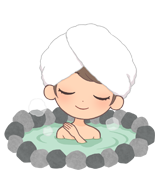
| Smoothly | Mushy | ||||||||||
|---|---|---|---|---|---|---|---|---|---|---|---|
| Powdery | Chewy | ||||||||||
| Fizzy | Tingling | ||||||||||
Skin feeling after bathing(5-point evaluation)
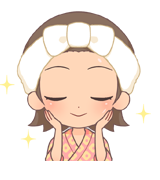
| Silky | Dryness | ||||||||||
|---|---|---|---|---|---|---|---|---|---|---|---|
| Powdery | Sticky | ||||||||||
| Moistly | Warmly | ||||||||||
View from the open-air bath (5-point evaluation)
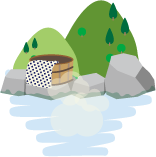
| Bamboo forest etc. |
| Large public baths for men and women |
| Point 3 |
|---|
Hot Spring Source Usage
| Water added No |
Heated No |
Disinfected No |
Circulated No |
Bath additive No |
|---|---|---|---|---|
| ○/× | ○/× | ○/× | ○/× | × |
| *Separate gender large baths and open-air baths "Tsubo-buro" / Private open-air baths "Kagao" and "Nayotake" / Open-air baths in guest rooms on the special top floor "Rokka" / Footbath "Yume no Shizuku"... 100% natural spring water *Separate gender large baths and open-air baths other than "Tsubo-buro" / Open-air baths in guest rooms of detached building "Tou" / Open-air baths in guest rooms on the 4th floor / Open-air baths in guest rooms of "Hana no Sho" on the 3rd floor... Natural spring water + circulating filtration (mixed with groundwater and tap water, heated, and circulated using chlorine-based disinfectants) | ||||
| Percentage of hot spring source |
97~100% | ||||
|---|---|---|---|---|---|
| Replacement frequency of hot spring water | *Private open-air baths: Every day *Open-air baths in all guest rooms: Every time a guest changes *Separate large baths and open-air baths for men and women: Once every 7 days |
||||
| Yield of hot spring water |
Private hot spring source on the premises: Powered pumping from 784m underground | ||||
| Distance from the source to the bathtub |
About 100m | ||||
| How hot spring water is drawn | Drawn by a pipe | ||||
| Temperature adjustment | *Private open-air bath / "Rokka" guest room open-air bath / "Yume no Shizuku" foot bath...the amount of water poured is adjusted *Separate large baths and open-air baths for men and women / detached guest room open-air baths / guest room open-air baths on the 4th floor / guest room open-air baths on the 3rd floor of "Hana no Sho"...the temperature is adjusted to the appropriate level by a system | ||||
| Drinking spring | NO *Contains 16 to 24 times more active ingredients than commercially available bath salts! | ||||
| "Gensen-Kakenagashi" Bath | Guest room Open-air Bath x 6, Private bath x 2 | ||||
Hot Spring Composition TableHot Spring Analysis Report
| Spring Quality | Sodium, Calcium - Chloride/Sulfate springs (Hypotonic, Weak Alkaline, High temperature spring) 旧泉質名:含石膏―弱食塩泉 |
|---|---|
| Color of hot spring | Clear and colorless |
| Scent of hot spring | Odorless |
| Dissolved substances | 2,450 mg/kg |
| Temperature of spring | 64.6℃ |
| pH | 8.3 (Weak Alkali) |
| Yield | About 59 liters per minute Amount of hot spring use per person (yield / bath capacity):About 0.72 liters/person(maximum capacity of 81 people) |
Hot Spring Composition (Amount contained in 1 kg of spring)
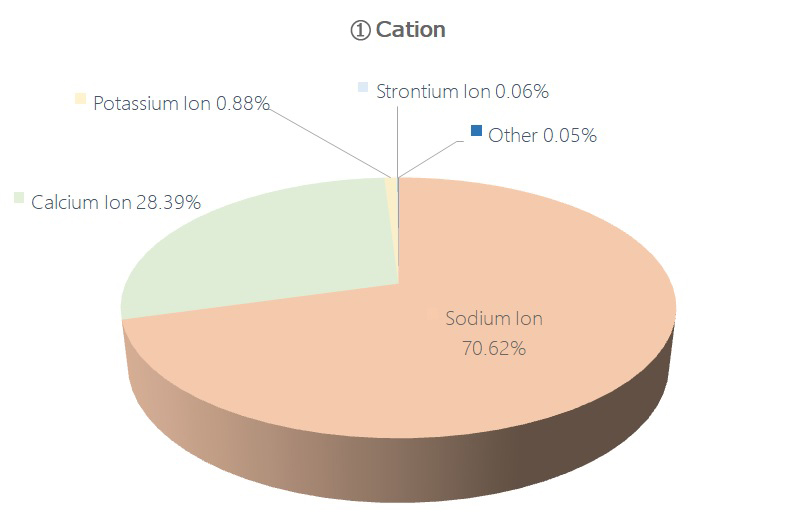 |
|||
|---|---|---|---|
| ①Cation | mg | mval | mval% |
| Sodium Ion (Na+)★ | 569 | 24.75 | 70.62 |
| Calcium Ion (Ca2+)★ | 203 | 9.95 | 28.39 |
| Potassium Ion (K+) | 12.0 | 0.31 | 0.88 |
| Strontium Ion (Sr2+) | 0.96 | 0.06 | 0.06 |
| Cations Total(1) | 785 | 35.05 | 100.00 |
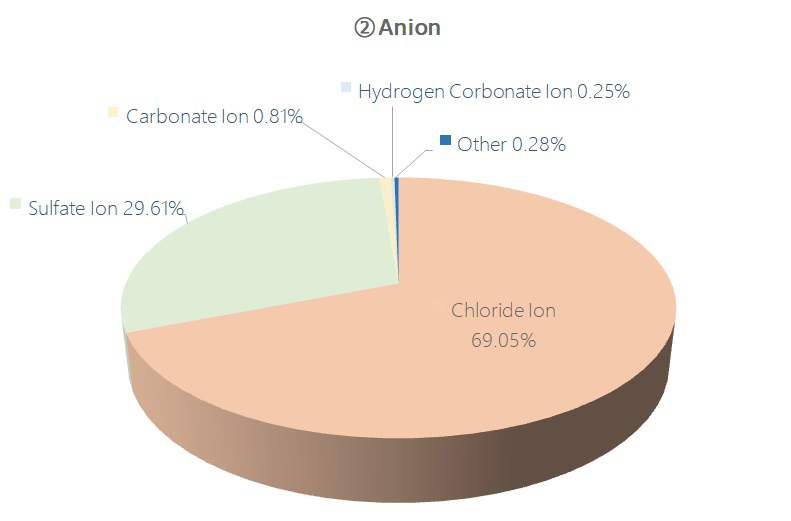 |
|||
|---|---|---|---|
| ②Anion | mg | mval | mval% |
| Chloride Ion (Cl-)★ | 971 | 27.39 | 69.05 |
| Sulfate Ion (SO42-)★ | 564 | 11.74 | 29.61 |
| Carbonate Ion (CO3-) | 9.60 | 0.32 | 0.81 |
| Hydrogen Corbonate Ion (HCO3-) | 6.10 | 0.10 | 0.25 |
| Anion Total(2) | 1555 | 39.66 | 100.00 |
| ③Undissociated Components | mg | mmol | |
|---|---|---|---|
| Metasilicic Acid (H2SiO3)★ | 62.6 | 0.80 | |
| Metaboric Acid (HBO2)★ | 46.6 | 1.06 | |
| Undissociated Components Total(3) | 109 | 1.87 | |
| Dissolved Gas Components | mg | mmol | |
|---|---|---|---|
| Free carbon dioxide (CO2) | <0.1 | 0.00 | |
| Free hydrogen sulfide (H2S) | - | 0.00 | |
| Dissolved Gas Components Total(4) | 0.1 | 0.00 | |
| Other Trace Components | |||
|---|---|---|---|
| - |
★are the components related to the "spring quality" and the components that qualify conditions for "Hot spring" and "Therapeutic hot spring".
Indications by Spring Quality for Bathing (Revised on July 1, 2014)
Cuts, Peripheral circulatory disturbance, Sensitivity to cold, Depression, Dry skin
General Indications for Bathing (Revised on July 1, 2014)
Chronic pains or stiffness of muscles or joints (chronic phase of rheumatoid arthritis, osteoarthritis, lower back pain, nerve pains, frozen shoulder, bruises, sprains, etc.),
Muscle stiffness by motor paralysis, Sensitivity to cold, Peripheral circulatory disturbance,
Gastrointestinal hypofunction (slow digestion, intestinal gas formation, etc.),
Mild hypertension, Impaired glucose tolerance (diabetes), Mild hypercholesterolemia,
Mild asthma or Emphysema, Hemorrhoidal pains, Autonomic instability,
Various symptoms from stress (sleep disorders, depression, etc.),
Restorative phase from illness, Recovery from fatigue, Health promotion
Contraindications by Spring Quality for Bathing (Revised on July 1, 2014)
None
General Contraindications for Bathing (Revised on July 1, 2014)
Active stage of diseases (especially when fever is accompanied), Active tuberculosis,
Advanced malignant tumor, or the case of significant debility involving severe anemia,
Severe cardiac or lung diseases involving suffocation feelings with a little movement,
Severe kidney disease involving edema, Gastrointestinal bleeding,
When bleeding is visible, Acute exacerbation stage of chronic diseases, etc.
Indications by Spring Quality for Drinking
Not drinkable ※Non-submission of application for drinking to the health department
Date of Analysis (The above hot spring composition table is cited from the survey data of the following institution)
March 26, 2024 (Kitasato Research Center for Environmental Science)
- ※Indications and contraindications for hot springs are in accordance with "Guideline to the Mineral Spring Analysis Methods" revised on July 1, 2014.
- ※Data was provided by the inn.
20 qualifications for "Hot spring" and 8 qualifications for "Therapeutic hot spring"
| Conditions/Components (contained amount in 1kg) ※If even one of the conditions is cleared, it is a "Hot spring" or "Therapeutic hot spring" |
A【Hot Springs Act】 Conditions of the "Hot spring" |
B【The Guideline for analysis of Kosen】 Conditions of the "Therapeutic hot spring" |
|
|---|---|---|---|
| 1 | Temperature (when collected from source) | 25℃ or more | |
| 2 | Dissolved substances (excluding gaseous) | Total amount 1,000mg or more | |
| 3 | Free carbon dioxide (CO2) | 250mg or more | 1000mg or more(Carbon dioxide springs) |
| 4 | Lithium Ion (Li+) | 1mg or more | ― |
| 5 | Strontium Ion (Sr2+) | 10mg or more | ― |
| 6 | Barium Ion (Ba2+) | 5mg or more | ― |
| 7 | Total Iron Ion[Fe2+(Iron(Ⅱ) Ferro ion)+Fe3+(Iron(Ⅲ) Ferri ion)] | 10mg or more | 20mg or more(Iron containing springs) |
| 8 | First Manganese Ion (Mn2+) | 10mg or more | ― |
| 9 | Hydrogen Ion (H+) | 1mg or more | 1mg or more (Acidic springs) |
| 10 | Bromine Ion (Br-) | 5mg or more | ― |
| 11 | Iodide Ion (I-) | 1mg or more | 10mg or more (Iodine containing springs) |
| 12 | Fluoride Ion (F-) | 2mg or more | ― |
| 13 | Hydro Arsenate Ion (HAsO42-) | 1.3mg or more | ― |
| 14 | Meta Arsenite (HAsO2) | 1mg or more | ― |
| 15 | Total sulfur (S) [HS-(Hydrogen sulfide ion)+S2O32-(Thiosulfate Ion)+H2S(Free hydrogen sulfide)] | 1mg or more | 2mg or more (Sulfur springs) |
| 16 | Metaboric acid (HBO2) | 5mg or more | ― |
| 17 | Metasilicic acid (H2SiO3) | 50mg or more | ― |
| 18 | Bicarbonate soda (NaHCO3) | 340mg or more | ― |
| 19 | Radon (Rn) | 20 or more (unit: ten ppb curie) 20×10-10Ci(curie)or more 20 or more(ten ppb curie) =74Bq(becquerel)/5.5mache or more |
30 nanocurie or more(Radioactive springs) 30×10-10Ci(curie)or more 30 or more(ten ppb curie) =111Bq(becquerel)/8.25 macheor more |
| 20 | Radium salt (as Ra) | 10-8mg or more 1/100 million mg or more |
― |
| Number of conditions cleared this "hot spring" or "therapeutic hot spring" is: | 4 (out of 20) | 2 (out of 8) | |
| Total 6 Points | |||
Hot Spring Legends and More
Traditionally documented efficacies
Smallpox
Historical figures who bathed in this hot spring
Many Sengoku period warlords, including Toyotomi Hideyoshi (1537-1598) during the Siege of Odawara (1590), bathed in Hakone's hot springs.
Celebrities who bathed in this hot spring
Numerous cultural and celebrity visitors, not mentioned due to private uses
Hot Spring (Onsen) Report
The name “Hakone KAMON” originates from a poem recited by the famous warlord Toyotomi Hideyoshi during the Odawara Campaign of 1590, which marked the end of the Warring States period. The gender-separated large communal baths and open-air baths were designed in the image of the “One-Night Castle” built at that time, giving visitors a taste of the grandeur experienced by the warlord himself.
This inn features its own private hot spring source that wells up within the premises. One significant advantage of this is the short distance between the source and the bath, which minimizes the introduction of impurities and the deterioration of water quality due to contact with air.
The spring quality is classified as a Sodium, Calcium - Chloride Sulfate springe, also formerly referred to as a weak salt spring containing gypsum.
Indications by Spring Quality unique to this spring include:
Cuts, Peripheral circulatory disturbance, Sensitivity to cold, Depression, Dry skin.
The Total Dissolved Substances (excluding gaseous substances) are 2,450 mg/kg, which is about 2.5 times the upper limit of simple hot springs (1,000 mg/kg), indicating a rich and potent therapeutic hot spring. Compared to commercially available bath additives, it contains 16 to 24 times more effective components.
Though the water is clear and colorless, it is undeniably a powerful therapeutic hot spring.
First, let’s focus on its weak alkalinity.
Human skin is typically slightly acidic. When immersed in a weakly alkaline hot spring, the old keratin on the skin reacts and dissolves, leaving the skin feeling smooth and supple after bathing. This is why alkaline springs are considered a representative type of hot springs for beautiful skin.
However, one should be cautious—dissolving old keratin also means the skin can easily dry out post-bath.
But no worries with this hot spring. Being a chloride spring in addition to weakly alkaline, the salt in the water forms a film over your skin, almost like a natural body pack, which helps retain moisture after bathing. This effect also slows post-bath perspiration and prevents rapid body heat loss, making it especially effective for those with sensitivity to cold, thus earning the name hot springs for warmth.
Additionally, the bactericidal effect of the salt helps soothe various skin conditions, and its effectiveness on cuts and burns gives chloride springs another name—hot springs for cuts.
Another noteworthy feature is its classification as a sulfate spring.
This spring promotes skin regeneration by stimulating metabolism, helping to improve skin conditions similar to chloride springs.
It’s known to be effective for cuts, burns, acne, psoriasis, itchiness, and chronic eczema.
Because of these properties, sulfate springs are also regarded as hot springs for cuts.
Moreover, since sulfate springs wash away excess skin oil, they are especially beneficial for oily skin.
They also promote oxygen supply to the blood, moisturize the skin, and improve its firmness and hydration—giving them a reputation as hot springs for rejuvenation.
Therefore, being a sulfate spring is one of the criteria for hot springs for beautiful skin.
Furthermore, the calcium ions in the spring have a calming effect, which is said to help with vascular conditions such as hypertension and arteriosclerosis, earning it the name hot springs for strokes.
Let’s not overlook components not listed in the official spring type.
It contains 62.6 mg/kg of metasilicic acid, surpassing the hot spring standard value (50 mg/kg). Known as a natural moisturizing agent, metasilicic acid is even used in some skincare products, contributing to the soft, hydrated feel after bathing.
Rich content of metasilicic acid is another hallmark of hot springs for beautiful skin.
Also noteworthy is its 46.6 mg/kg of metaboric acid, which is over nine times the hot spring standard (5 mg/kg)—an astonishing amount.
Metaboric acid is known for its bacteriostatic and cleansing effects, and it is said to help prevent acne.
Some of the open-air baths in the large public bath area, as well as the private open-air baths and rooftop room-attached baths, are free-flowing hot spring baths. The others are maintained with circulation filtration systems that mix fresh spring water with groundwater.
A free-flowing hot spring means the water constantly flows into the bath and overflows without recycling—ensuring constant exposure to fresh hot spring water.
This is a luxurious style, ideal for those who want to enjoy the full benefits of hot spring components.
However, in large communal baths used by many guests, fully free-flowing systems can pose hygiene concerns if bathers neglect proper washing before entry.
To maintain cleanliness, these areas mostly use a combined system of 100% natural free-flowing hot spring and circulation filtration, with chlorine disinfection as needed.
It's also worth noting that chloride springs and sulfate springs are generally more resistant to quality degradation compared to other types.
Despite having only 18 rooms (14 with hot spring baths), the inn offers about 10 different types of baths in the gender-separated large bath and open-air bath areas.
Even when fully booked, there’s rarely any crowding.
This inn prides itself on offering guests a relaxed and spacious hot spring experience.
Rates Data
| 1 night/2 meals fee | From 29,150 yen (tax included) |
|---|---|
| Stay without meals | From 19,800 yen (tax included) |
| Staying alone | - |
| Private bath fee when overnight stay |
2,750yen(45 min) |
| Day stay | Adults: 1,980 yen (including yukata) Infants/children: 1,100 yen |
| Private bath for day-stay |
2,750yen (45 mins) Weekdays only, reservations required one week in advance |
Facility Data
| Establishment | Established in 1996 |
|---|---|
| Check-In | 2:00 p.m. |
| Check-Out | 11:00 a.m. |
| Location and Environment | Mountains / bamboo forests |
| Number of Rooms | All 18 rooms |
| Number of People Accommodated |
81 persons |
| Parking Area | Available for 50 cars |
| Facilities | Banquet hall, shop, rest area |
| Internet | Wi-Fi available |
| Barrier Free | Supported |
| Toilet with washer | Equipped |
Transportation Access
| By train | 12 minutes walk from Hakone-Yumoto Station |
|---|---|
| Shuttle bus | Yes【Pick-up service at Kaminoyama Onsen Station by TEL upon arrival (for overnight guests only)】 |
| By car | From Tokyo: Approximately 40 minutes on the Odawara Atsugi Road from the Atsugi IC on the Tomei Expressway. From Nagoya: Approximately 4 hours via the Gotemba IC on the Tomei Expressway or the Mishima-Tsukahara IC on the Izu-Jukan Expressway. |
| Address | 435, Yumoto, Hakone-machi, Ashigarashimo-gun, Kanagawa-ken, 250-0311, JAPAN, TEL:+81-460-85-5050 |

